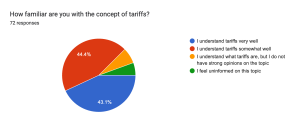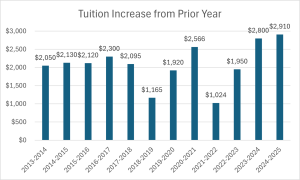
Of the 49 states that allow voters to amend their constitutions through ballot measures, Florida maintains the highest supermajority threshold for amendments to cross. This distinction came into sharp focus on November 5, 2024, when Amendment 4, despite majority support, failed to breach the required 60-percent vote.
That is not to say the 60-percent supermajority is impossible for all amendments to cross. Amendment 2 was the only of the 6 amendments on Florida’s ballot this year to pass. The proposal to make fishing and hunting a constitutional right passed with a resounding 67-percent majority.
“Of all states that have some process to put ballot initiatives or state constitutional amendments on the ballot, only two of them require a supermajority: Florida and Colorado,” said Patrick Rickert, Assistant Professor of Political Science at Rollins College. “And Colorado’s is 55 percent, so Florida’s is obviously the highest.”
This 60-percent supermajority threshold was not always the case in Florida. In 2006, Florida proposed Amendment 3 which would establish a supermajority vote to be necessary to pass a constitutional amendment. This vote passed with a 57.78-percent approval, making it just shy of the 57.16-percent approval of Amendment 4 in the 2024 election.
“The big challenge is that you can get a majority and still lose—and a pretty strong majority,” said Rickert. “If you think of, for instance, if you needed 60 percent of the vote for Florida to award its electoral votes, we wouldn’t have chosen a president.”
This election cycle, 10 states had amendments on their ballot addressing abortion access. The defeat of Amendment 4 in Florida made the state the only one to fail the amendment despite majority support. Of the 10 states, 7 states went on to pass amendments on abortion access.
These limitations on amendment passage are not exclusive to the 2006 decision. In 2020, Florida voters had to vote on Amendment 4, or the Think Twice Initiative, which would require constitutional amendments to pass twice in order to be ratified.
“It is part of a fairly consistent trend throughout American history for the party in power to try and make it harder for their opponents to get their priorities passed, and of course this isn’t something novel to Florida,” said Rickert.
Among the many outcomes of this election was the retaining of the Republican supermajority in the Florida state legislature. Professor Rickert foretells this tension as being a large influence in the establishment of these supermajority thresholds.
“The Republicans have been in power consistently, but for a lot of the time that that party has been in power, there’s been a strong, but not quite strong enough, Democratic minority nipping at the heels,” said Rickert. “Other states that have one-party dominance don’t need supermajority requirements because the minority party is never even going to get a majority.”
Even if abortion was to be voted on again in the 2028 election, there is no telling if it would be able to breach the 60-percent threshold needed. With the failing of Amendment 4, Florida’s current 6-week abortion ban will remain in effect.
Many news outlets have proclaimed voter turnout as a likely source of the outcomes in the 2024 election. However, Professor Rickert sees something bigger as the cause.
“I don’t think turnout is the story of this election,” said Rickert. “It really is a shift, at least on the presidential side. Turnout looked fairly similar to what it looked like in 2020, with some changes among demographic groups, but we don’t really have data to support massive shifts. I think this is mostly just people who changed their mind.”











Comments are closed.